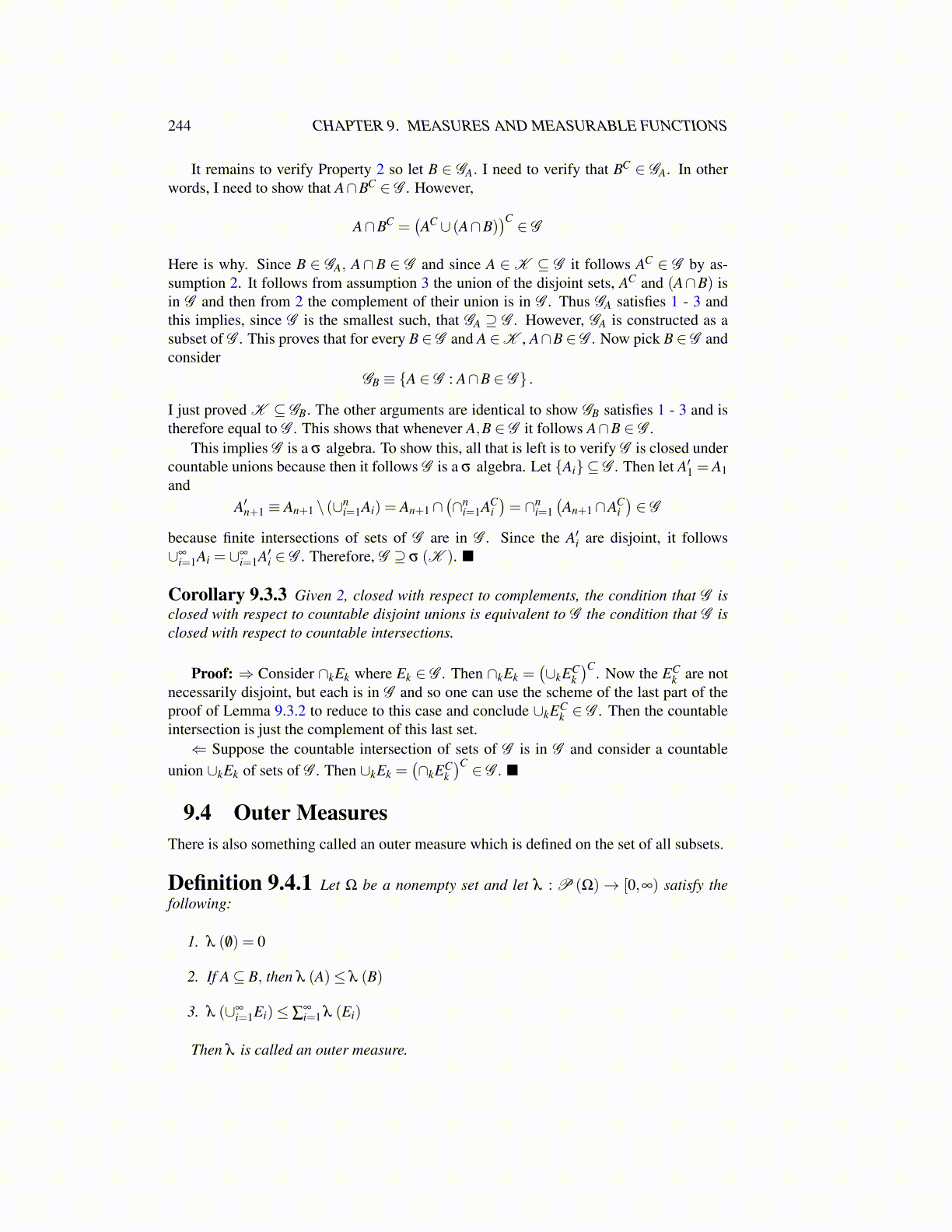
244 CHAPTER 9. MEASURES AND MEASURABLE FUNCTIONS
It remains to verify Property 2 so let B ∈ GA. I need to verify that BC ∈ GA. In otherwords, I need to show that A∩BC ∈ G . However,
A∩BC =(AC ∪ (A∩B)
)C ∈ G
Here is why. Since B ∈ GA, A∩B ∈ G and since A ∈K ⊆ G it follows AC ∈ G by as-sumption 2. It follows from assumption 3 the union of the disjoint sets, AC and (A∩B) isin G and then from 2 the complement of their union is in G . Thus GA satisfies 1 - 3 andthis implies, since G is the smallest such, that GA ⊇ G . However, GA is constructed as asubset of G . This proves that for every B ∈ G and A ∈K , A∩B ∈ G . Now pick B ∈ G andconsider
GB ≡ {A ∈ G : A∩B ∈ G } .
I just proved K ⊆ GB. The other arguments are identical to show GB satisfies 1 - 3 and istherefore equal to G . This shows that whenever A,B ∈ G it follows A∩B ∈ G .
This implies G is a σ algebra. To show this, all that is left is to verify G is closed undercountable unions because then it follows G is a σ algebra. Let {Ai} ⊆ G . Then let A′1 = A1and
A′n+1 ≡ An+1 \ (∪ni=1Ai) = An+1∩
(∩n
i=1ACi)= ∩n
i=1(An+1∩AC
i)∈ G
because finite intersections of sets of G are in G . Since the A′i are disjoint, it follows∪∞
i=1Ai = ∪∞i=1A′i ∈ G . Therefore, G ⊇ σ (K ). ■
Corollary 9.3.3 Given 2, closed with respect to complements, the condition that G isclosed with respect to countable disjoint unions is equivalent to G the condition that G isclosed with respect to countable intersections.
Proof: ⇒ Consider ∩kEk where Ek ∈ G . Then ∩kEk =(∪kEC
k
)C. Now the ECk are not
necessarily disjoint, but each is in G and so one can use the scheme of the last part of theproof of Lemma 9.3.2 to reduce to this case and conclude ∪kEC
k ∈ G . Then the countableintersection is just the complement of this last set.⇐ Suppose the countable intersection of sets of G is in G and consider a countable
union ∪kEk of sets of G . Then ∪kEk =(∩kEC
k
)C ∈ G . ■
9.4 Outer MeasuresThere is also something called an outer measure which is defined on the set of all subsets.
Definition 9.4.1 Let Ω be a nonempty set and let λ : P (Ω)→ [0,∞) satisfy thefollowing:
1. λ ( /0) = 0
2. If A⊆ B, then λ (A)≤ λ (B)
3. λ (∪∞i=1Ei)≤ ∑
∞i=1 λ (Ei)
Then λ is called an outer measure.